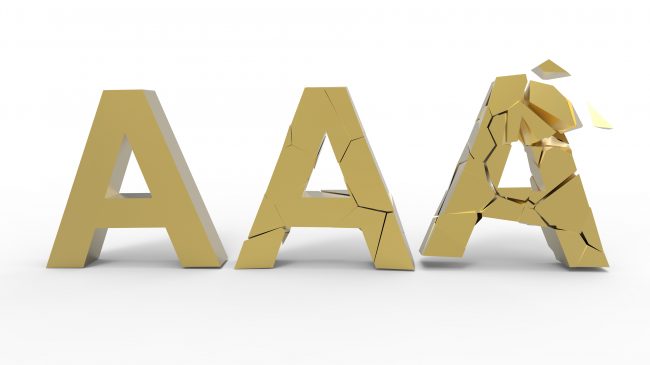The credit rating business began in the early 20th century when John Moody and his competitors started publishing letter grades in the corporate and municipal bond manuals they marketed to investors. By consolidating copious volumes of financial data and commentary in a single source, early rating agencies provided fixed income investors with a then-unheard-of level of transparency. But while the rating business began as a disruptive fintech innovation (more than 100 years before “fintech” became a word), decades of federal regulation have had the unintended consequence of stymying progress in the field of institutional credit risk analysis. Credit rating agencies are slow to embrace new analytical techniques that would create value for fixed income investors, while often competing for issuer business by lowering their credit standards.
For decades, consumer credit reporting firms have been using computer models to automatically rate individuals on a continuous numeric scale. By contrast, corporate credit rating agencies rely heavily on human analysts and continue to use opaque letter grades. This difference may be attributed to the fact that consumer credit reporting firms are lightly regulated, while the traditional corporate credit ratings business model has been cemented into federal regulations since 1931.
For decades, consumer credit reporting firms have been using computer models to automatically rate individuals on a continuous numeric scale. By contrast, corporate credit rating agencies rely heavily on human analysts and continue to use opaque letter grades.
In the 1930s regulators were seeking a way to determine which companies should be included in or excluded from bank commercial lending portfolios. They decided to use the letter grades in rating manuals for this purpose. In 1975, regulators employed ratings for broker-dealer capital requirements, and by the end of the 20th century had embedded ratings in hundreds of securities, pension, banking, real estate, and insurance regulations. They also created a system for licensing and regulating rating firms, known in regulation as Nationally Recognized Statistical Rating Organizations (NRSROs)—an ironic moniker given the agencies’ limited use of statistical techniques.
Bond issuers and rating agencies realized that ratings had become a device for determining whether many institutional investors could legally purchase particular fixed income securities. Because ratings now provided a regulatory license, they were especially valuable to issuers. Rating agencies monetized this regulatory power by charging issuers for ratings instead of selling them to investors.
Because ratings now provided a regulatory license, they were especially valuable to issuers. Rating agencies monetized this regulatory power by charging issuers for ratings instead of selling them to investors.
The unintended consequence was the phenomenon of “ratings shopping” in which issuers pitted rating agencies against one another to win rating mandates through lower standards. This was exacerbated by a less obvious unintended consequence of regulation, which is that it stunted the growth of alternative credit analysis providers who found it more difficult to sell their services to fixed income investors, given the availability of issuer-paid credit ratings at no out-of-pocket cost. In other words, companies that might have provided more accurate ratings were crowded out by the regulatory privileges created by NRSRO status.
Far from protecting investors, the regulatory privileges given to NRSROs made it more difficult for investors to understand the true risks of bonds, with far-reaching consequences. This became apparent during the great financial crisis when it emerged that from the early 2000s NRSROs had assigned inflated ratings to thousands of Residential Mortgage Backed Securities (RMBS) as well as derivative instruments such as Collateralized Debt Obligations (CDOs). The lenient ratings attracted excessive mortgage finance capital that exacerbated a home price bubble—and a wider asset price bubble. It was the bursting of this bubble that triggered the Great Recession of 2007–2009.
Other notable rating agency failures in the aughts included the investment grade ratings they maintained on Enron and WorldCom until shortly before their respective bankruptcies; AAA ratings for bond insurers, most of whom experienced credit events during the Great Recession; and inflated ratings on aircraft receivable and manufactured housing securitizations.
The 2010 Dodd-Frank Act addressed the credit rating agency issue, but the benefits have been limited. On the positive side, Dodd-Frank mandated the removal of credit ratings from regulations—a process that unfortunately remains incomplete. On the downside, it stiffened NRSRO registration and reporting requirements, increasing the cost of entry for prospective entrants and thus limiting the prospects for new competition and much- needed industry disruption. Even today, three firms continue to dominate the credit rating market.
The Financial CHOICE Act, passed by the House in June 2017, relaxes some Dodd-Frank regulations but leaves most of the regulatory framework in place. If and when the CHOICE Act is taken up in a House-Senate conference, lawmakers should consider further pro-competitive reforms, or, better yet, they should eliminate the system of NRSRO registration and regulation entirely.
If and when the CHOICE Act is taken up in a House-Senate conference, lawmakers should consider further pro-competitive reforms, or, better yet, they should eliminate the system of NRSRO registration and regulation entirely.
If the regulatory straitjacket was removed, credit analysts would be free to compete with one another on a level playing field. The results would likely be less pro-issuer bias and much greater use of information technology in the assignment and monitoring of credit ratings. The benefit would be a more effective credit rating industry—one better positioned to safeguard the economy against systemic disruptions like those that triggered the Great Recession.

